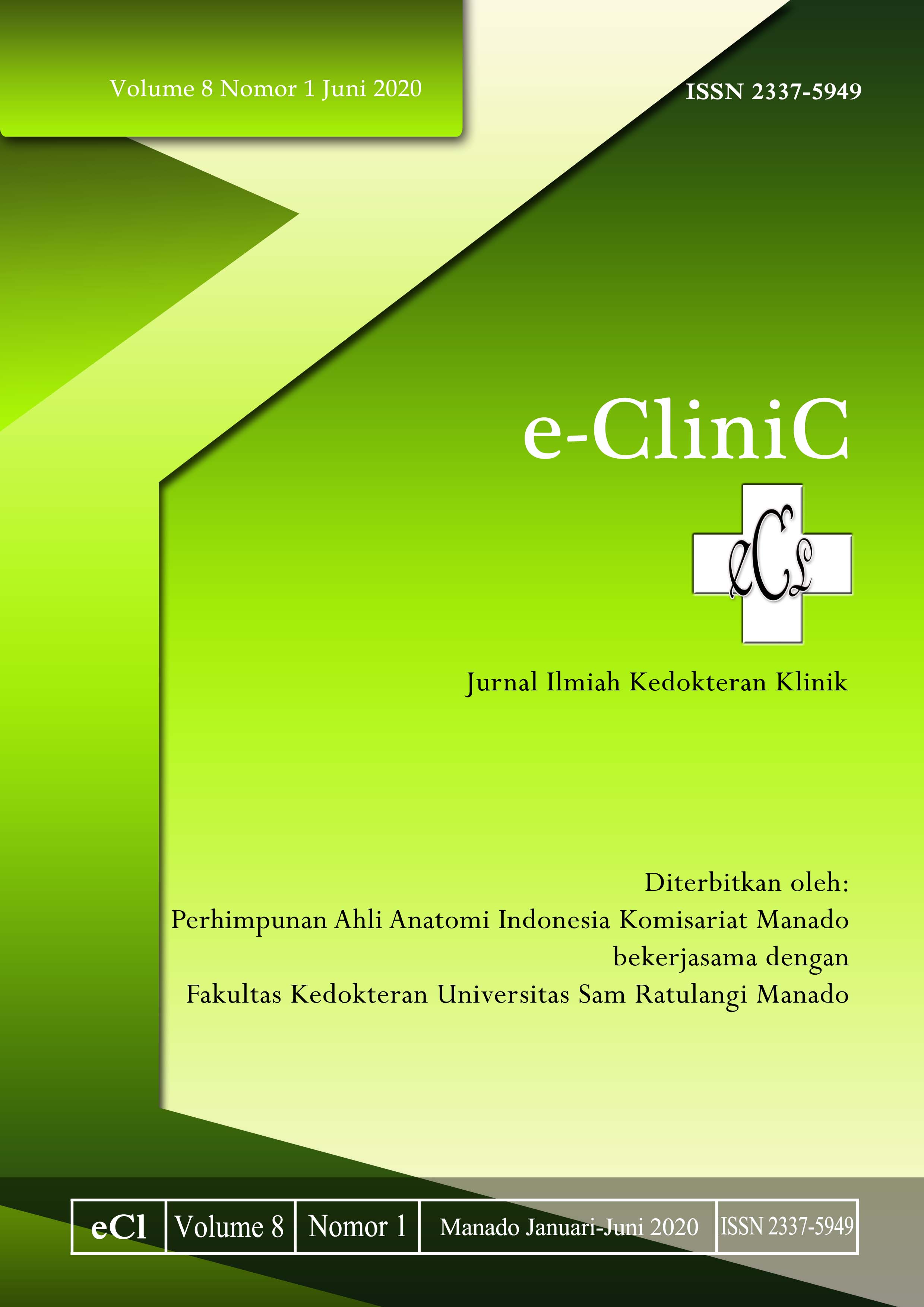Hubungan neutrophyl to lymphocyte ratio dengan derajat disfungsi diastolik pada pasien hipertensi
DOI:
https://doi.org/10.35790/ecl.v8i1.28607Abstract
Abstract: Uncontrolled hypertension is the leading cause of the increased morbidity and mortality of congestive heart failure in developed countries. Moreover, diastolic dysfunction is the leading cause of heart failure in patients with hypertension. However, diagnosis as well as therapy of patients with hypertension and diastolic dysfunction is still a problem and the mechanism is still unclear, leading to the need of a parameter study as an initial predictor. In cardiovascular diseases, it is connected to the rise in neutrophil to lymphocyte ratio (NLR). This study was aimed to identify the relationship between NLR and the degree of diastolic dysfunction in patients with hypertension. This was an analytical and descriptive study with a cross sectional design. Variables included the NLR and the degree of diastolic dysfunction in patients with hypertension. The results obtained 31 patients, and highest percentages were males (24 patients; 77.42%), aged 61-65 years old (12 patients; 38.71%), and BMI scaling as overweight (17 patients; 54.83%). Most of the patients were categorized as normotension (12 patients; 38.71%). The majority of diastolic dysfunction degree was the 1st degree numbering 17 patients (54.84%). Minimum value of the NLR was 0.09 and the maximum was 19 with a standard deviation of 2.04. The Spearman’s parametric test showed a p-value of 0.315 and an r-value of 0.173 for the relationship between the NLR and the degree of diastolic dysfunction in patients with hypertension. In conclusion, there was no relationship between the NLR and degree of diastolic dysfunction in patients with hypertension.
Keywords: neutrophil to lymphocyte ratio, diastolic dysfunction degree, hypertension
Â
Abstrak: Hipertensi yang tidak terkontrol merupakan penyebab utama meningkatnya morbiditas dan mortalitas gagal jantung kongesti di negara berkembang. Selain itu, disfungsi diastolik menjadi penyebab utama gagal jantung pada pasien hipertensi. Namun, penegakan diagnosis dan terapi pada pasien hipertensi dengan disfungsi diastolik masih menjadi masalah dan mekanismenya masih kurang dipahami sehingga diperlukan suatu parameter sebagai prediktor awal. Penyakit-penyakit kardiovaskular dikaitkan dengan peningkatan neutrophyl to lymphocyte ratio (NLR). Penelitian ini bertujuan untuk mengetahui hubungan NLR dengan derajat disfungsi diastolik pada pasien hipertensi. Jenis penelitian ialah deskriptif analitik dengan desain potong lintang. Variabel yang dianalisis ialah NLR dan derajat disfungsi diastolik pasien hipertensi. Hasil penelitian mendapatkan 31 sampel, dan persentase tertinggi ialah jenis kelamin laki-laki (24 pasien; 77,42%), usia pada rentang 61-65 (12 pasien; 38,71%), dengan IMT overweight (17 pasien; 54,83%). Kategori hipertensi terbanyak ialah kategori normal (12 pasien; 38,71%). Derajat disfungsi diastolik terbanyak ditemukan pada derajat 1 (17 pasien; 54,84%). Nilai minimum NLR 0,09 dan maksimum 10 dengan simpangan baku 2,04. Uji parametrik Spearman mendapatkan nilai p=0,315 dan r=0.173 untuk hubungan antara NLR dengan derajat disfungsi diastolik pada pasien hipertensi. Simpulan penelitian ini ialah tidak terdapat hubungan antara NLR dengan derajat disfungsi diastolik pada pasien hipertensi.
Kata kunci: neutrophil to lymphocyte ratio, derajat disfungsi diastolik, hipertensi
Downloads
How to Cite
Issue
Section
License
COPYRIGHT
Authors who publish with this journal agree to the following terms:
Authors hold their copyright and grant this journal the privilege of first publication, with the work simultaneously licensed under a Creative Commons Attribution License that permits others to impart the work with an acknowledgment of the work's origin and initial publication by this journal.
Authors can enter into separate or additional contractual arrangements for the non-exclusive distribution of the journal's published version of the work (for example, post it to an institutional repository or publish it in a book), with an acknowledgment of its underlying publication in this journal.
Authors are permitted and encouraged to post their work online (for example, in institutional repositories or on their website) as it can lead to productive exchanges, as well as earlier and greater citation of the published work (See The Effect of Open Access).







